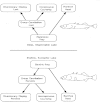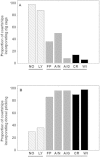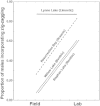Evolutionary Influences of Plastic Behavioral Responses Upon Environmental Challenges in an Adaptive Radiation
- PMID: 26163679
- PMCID: PMC4642688
- DOI: 10.1093/icb/icv083
Evolutionary Influences of Plastic Behavioral Responses Upon Environmental Challenges in an Adaptive Radiation
Abstract
At the end of the 19th century, the suggestion was made by several scientists, including J. M. Baldwin, that behavioral responses to environmental change could both rescue populations from extinction (Baldwin Effect) and influence the course of subsequent evolution. Here we provide the historical and theoretical background for this argument and offer evidence of the importance of these ideas for understanding how animals (and other organisms that exhibit behavior) will respond to the rapid environmental changes caused by human activity. We offer examples from long-term research on the evolution of behavioral and other phenotypes in the adaptive radiation of the threespine stickleback fish (Gasterosteus aculeatus), a radiation in which it is possible to infer ancestral patterns of behavioral plasticity relative to the post-glacial freshwater radiation in northwestern North America, and to use patterns of parallelism and contemporary evolution to understand adaptive causes of responses to environmental modification. Our work offers insights into the complexity of cognitive responses to environmental change, and into the importance of examining multiple aspects of the phenotype simultaneously, if we are to understand how behavioral shifts contribute to the persistence of populations and to subsequent evolution. We conclude by discussing the origins of apparent novelties induced by environmental shifts, and the importance of accounting for geographic variation within species if we are to accurately anticipate the effects of anthropogenic environmental modification on the persistence and evolution of animals.
© The Author 2015. Published by Oxford University Press on behalf of the Society for Integrative and Comparative Biology. All rights reserved. For permissions please email: journals.permissions@oup.com.
Figures







Similar articles
-
Life-history plasticity in female threespine stickleback.Heredity (Edinb). 2015 Oct;115(4):322-34. doi: 10.1038/hdy.2015.65. Epub 2015 Aug 19. Heredity (Edinb). 2015. PMID: 26286665 Free PMC article. Review.
-
Iterative development and the scope for plasticity: contrasts among trait categories in an adaptive radiation.Heredity (Edinb). 2015 Oct;115(4):335-48. doi: 10.1038/hdy.2015.66. Epub 2015 Aug 5. Heredity (Edinb). 2015. PMID: 26243135 Free PMC article. Review.
-
Repeatability of Adaptive Radiation Depends on Spatial Scale: Regional Versus Global Replicates of Stickleback in Lake Versus Stream Habitats.J Hered. 2020 Feb 5;111(1):43-56. doi: 10.1093/jhered/esz056. J Hered. 2020. PMID: 31690947
-
The role of variation and plasticity in parental care during the adaptive radiation of three-spine sticklebacks.Evolution. 2019 May;73(5):1037-1044. doi: 10.1111/evo.13711. Epub 2019 Mar 25. Evolution. 2019. PMID: 30843599 Free PMC article.
-
Evolution of growth by genetic accommodation in Icelandic freshwater stickleback.Proc Biol Sci. 2013 Oct 16;280(1772):20132197. doi: 10.1098/rspb.2013.2197. Print 2013 Dec 7. Proc Biol Sci. 2013. PMID: 24132309 Free PMC article.
Cited by
-
Life-history plasticity in female threespine stickleback.Heredity (Edinb). 2015 Oct;115(4):322-34. doi: 10.1038/hdy.2015.65. Epub 2015 Aug 19. Heredity (Edinb). 2015. PMID: 26286665 Free PMC article. Review.
-
A Behavioral Syndrome Linking Boldness and Flexibility Facilitates Invasion Success in Sticklebacks.Am Nat. 2022 Dec;200(6):846-856. doi: 10.1086/721765. Epub 2022 Oct 20. Am Nat. 2022. PMID: 36409977 Free PMC article.
-
Adaptability and evolution.Interface Focus. 2017 Oct 6;7(5):20160126. doi: 10.1098/rsfs.2016.0126. Epub 2017 Aug 18. Interface Focus. 2017. PMID: 28839914 Free PMC article. Review.
-
Metamorphosis Reverses the Behavioral Phenotype in Rana arvalis Along a Latitudinal Gradient.Ecol Evol. 2025 Aug 13;15(8):e71945. doi: 10.1002/ece3.71945. eCollection 2025 Aug. Ecol Evol. 2025. PMID: 40809828 Free PMC article.
References
-
- Armstrong EA. 1949. Diversionary display. Part 2. The nature and origin of distraction display. Ibis 91:179–88.
-
- Baker JA, Heins DC, King RW, Foster SA. 2011. Rapid shifts in multiple life-history traits in a population of threespine stickleback. J Evol Biol 24:863–70. - PubMed
-
- Baker JA, Wund MA, Chock RY, Ackein L, Elsemore R, Foster SA. 2010. Predation history and vulnerability: Conservation of the stickleback adaptive radiation. Biol Conserv 143:1184–92.
-
- Baker JA, Heins DC, Foster SA, King RW. 2008. An overview of life-history variation in female threespine stickleback. Behaviour 145:579–602.
Publication types
MeSH terms
LinkOut - more resources
Full Text Sources
Other Literature Sources

